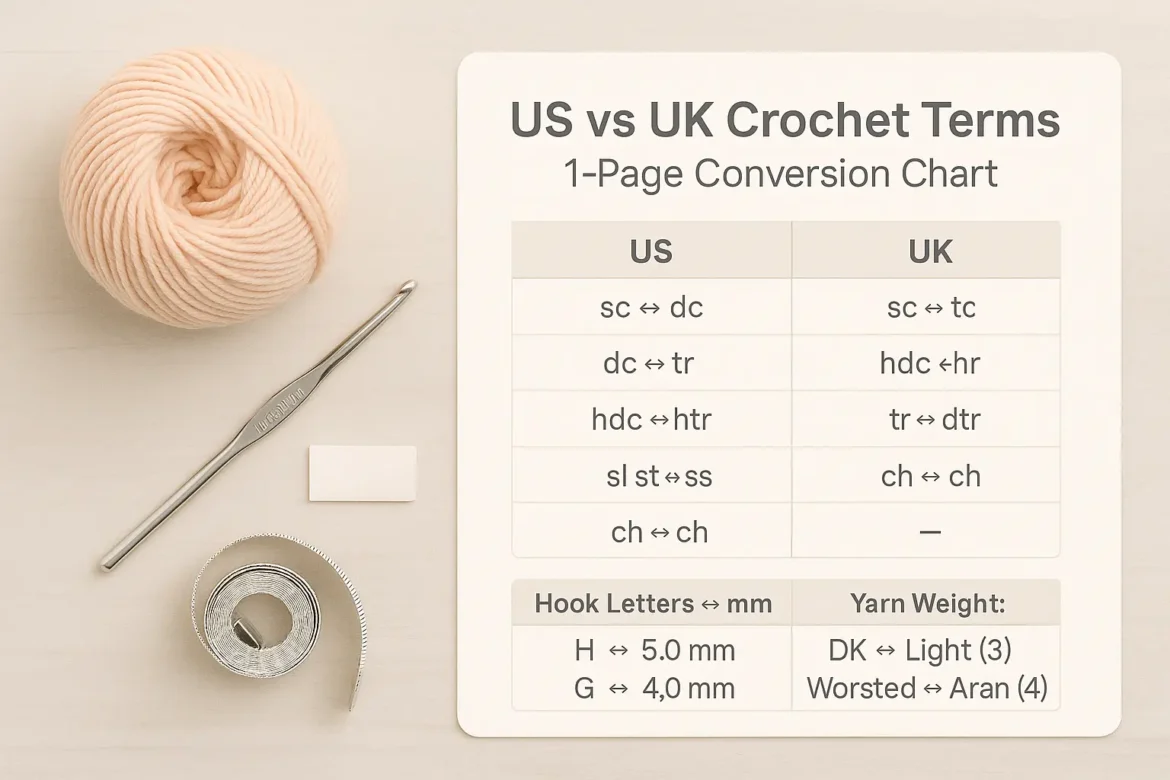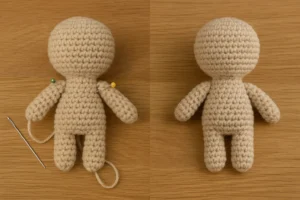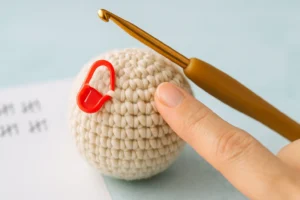If you’ve ever opened a pattern and thought your double crochet looks “off,” you’ve likely hit the US vs UK crochet terms wall. Relax the stitches are worked the same way; only the names differ. This guide gives you the US vs UK crochet terms conversion chart you actually need (an easy uk vs us crochet terms chart), plus quick tests to spot a pattern’s language, hook letter-to-mm conversions, and yarn weight equivalents so you can translate any line in seconds.
New to amigurumi or switching terminology for the first time? Start with these foundations:
- First-Amigurumi: Step-By-Step Guide
- How to Read an Amigurumi Pattern
- Yarn Weight, Gauge & Hook Size Guide
Quick rule to keep in mind while you read: US single crochet (sc) = UK double crochet (dc), and most UK names are one step higher than US names (US dc ↔ UK treble).
For official sizing context, see the Craft Yarn Council’s hook/yarn standards
Jump to section
Core Stitch Conversion Chart (US ↔ UK)
Use this uk vs us crochet terms chart to translate any pattern line instantly. Remember: the stitches are worked the same; only the names change.
| US Term | US Abb. | UK Term | UK Abb. |
|---|---|---|---|
| slip stitch | sl st | slip stitch | ss |
| chain | ch | chain | ch |
| single crochet | sc | double crochet | dc |
| half double crochet | hdc | half treble crochet | htr |
| double crochet | dc | treble crochet | tr |
| treble (triple) crochet | tr | double treble crochet | dtr |
| double treble crochet | dtr | triple treble crochet | ttr |
| picot | picot | picot | picot |
| front post double crochet | fpdc | front post treble crochet | fptr |
| back post double crochet | bpdc | back post treble crochet | bptr |
Rule of thumb: For the “plain” stitches, UK = US + 1 step (US sc → UK dc, US dc → UK tr, etc.).
Want to practice right away? Try a small project like the Crochet Bee Pattern and read this chart side-by-side with the instructions.
Pattern Language & Abbreviation Differences
Beyond stitch names, patterns use different phrasing in US vs UK crochet terms. Keep this mini-glossary handy when translating instructions.
| US Pattern Language | UK Equivalent | Notes |
|---|---|---|
| gauge | tension | Same concept; check our Yarn Weight, Gauge & Hook Size Guide. |
| skip (a stitch) | miss (a stitch) | “Skip 1” ↔ “Miss 1.” |
| yarn over (yo) | yarn over hook (yoh) | Same motion; different wording. |
| sc2tog | dc2tog | Decrease of the smallest basic stitch in each system. |
| dc2tog | tr2tog | Match decreases to the converted base stitch. |
| back loop only (blo) | blo | Same abbreviation in both systems. |
| front loop only (flo) | flo | Same abbreviation in both systems. |
| front post double crochet (fpdc) | front post treble (fptr) | Post stitches “step up” in UK too. |
| back post double crochet (bpdc) | back post treble (bptr) | As above. |
Hook Size Conversion (US Letters ↔ mm)
When translating US vs UK crochet terms, hooks can be a second confusion point. Use metric (mm) whenever possible, it’s universal and avoids letter mismatches.
| US Letter | Metric (mm) | US Letter | Metric (mm) |
|---|---|---|---|
| B-1 | 2.25 | H-8 | 5.0 |
| C-2 | 2.75 | I-9 | 5.5 |
| D-3 | 3.25 | J-10 | 6.0 |
| E-4 | 3.5 | K-10.5 | 6.5 |
| F-5 | 3.75 | L-11 | 8.0 |
| G-6 | 4.0 | M/N-13 | 9.0 |
| 7 | 4.5 | N/P-15 | 10.0 |
Tip: If a pattern lists only a letter (e.g., “H hook”), convert it to mm with this table to match your tension accurately.
Yarn Weight Equivalents (US ↔ UK/Int’l)
Translating US vs UK crochet terms often also means matching yarn categories. Use this table to keep fabric thickness consistent when you switch patterns across regions.
| US Term | UK/Int’l Term | CYC # | Typical Hook (mm) |
|---|---|---|---|
| Lace | Lace | 0 | 1.5–2.25 |
| Super Fine (Fingering) | 4-ply | 1 | 2.25–3.25 |
| Fine (Sport) | sometimes 5-ply | 2 | 3.25–3.75 |
| Light (DK) | Double Knitting (DK) | 3 | 3.75–4.5 |
| Medium (Worsted) | Aran | 4 | 4.5–5.5 |
| Bulky | Chunky | 5 | 6.0–6.5 |
| Super Bulky | Super Chunky | 6 | 8.0–10.0 |
| Jumbo | — | 7 | 12.0+ |
Tip: Match yarn weight first, then fine-tune hook size for your tension/gauge. This keeps stitch counts identical while your fabric drape stays correct.
How to Tell if a Pattern Is US or UK (10-Second Test)
Need a fast check before you start? Use this mini flow:
- Scan the abbreviations box.
- If you see sc = single crochet, it’s US.
- If dc is the smallest basic stitch and there’s no sc, it’s UK.
- Read one instruction line.
- Example: “Rnd 4: (sc, inc) x 6” ⇒ US.
- Example: “Row 5: tr in each st” ⇒ UK.
- Language clues.
- US: gauge, color, yo, skip.
- UK: tension, colour, yoh, miss.
- Hook listing style.
- Letters + mm (e.g., H/5.0 mm) often signals US.
- mm-only is common everywhere but typical in UK publications.
- Designer/location context (optional).
Helpful hint, but not foolproof—many designers publish in both systems.
Real-World Conversion Examples (Amigurumi)
Use these quick swaps to translate any line without changing stitch counts or shaping.
US → UK
Rnd 4: (sc, inc) x 6 — 18 sts
→Rnd 4: (dc, inc) x 6 — 18 stsRnd 8: (2 sc, sc2tog) x 6 — 18 sts
→Rnd 8: (2 dc, dc2tog) x 6 — 18 stsRow 6: dc in each st
→Row 6: tr in each st
UK → US
Row 3: tr across
→Row 3: dc acrossRnd 5: (2 dc, dc2tog) x 6(UK)
→Rnd 5: (2 sc, sc2tog) x 6(US)
Colorwork phrasing swap
Change color, sl st to join, ch 1, work in blo(US)
→Change colour, ss to join, ch 1, work in blo(UK)
Practice with small projects (great for testing US vs UK crochet terms):
- Beginner-friendly shaping: Crochet Bee Pattern
- Short rounds & decreases: Crochet Frog Keychain (Free)
- Row/round mixes with color pops: Lucky Rainbow Koi Fish Keychain
Quick “Flow” Checklist (Translate Any Line Fast)
- Find the smallest basic stitch used (sc vs dc).
- Apply the one-step rule: US→UK +1 step (sc→dc, dc→tr); UK→US −1 step.
- Convert decreases accordingly (sc2tog ↔ dc2tog; dc2tog ↔ tr2tog).
- Do not change stitch counts or shaping—only names change.
- Convert hook letters ↔ mm so your tension matches.
- Match yarn weight category (DK, Worsted/Aran, etc.), then fine-tune hook size for tension.
FAQ (US vs UK Crochet Terms)
Do stitch counts change when I convert?
No. Only the names change; stitch counts and shaping stay the same.
Is US dc the same as UK dc?
No. US double crochet (dc) = UK treble (tr). UK double crochet (dc) = US single crochet (sc).
Which terms match exactly in both systems?
Slip stitch (sl st/ss) and chain (ch) match.
What about decreases like sc2tog and dc2tog?
Convert them with the one-step rule:
US sc2tog ↔ UK dc2tog
US dc2tog ↔ UK tr2tog
How do I tell a pattern’s system fast?
Check the abbreviations: if sc appears as the smallest basic stitch, it’s US. If dc is the smallest, it’s UK.
Hooks confuse me—letters vs mm?
Use metric (mm) as the universal reference, and map letters to mm with the table in this guide.
Do yarn weights differ between regions?
Names vary (Worsted vs Aran, DK is common in both), but you can align by weight category and then fine-tune hook size for tension.
US vs UK crochet terms confuse many beginners, but the stitches are worked the same way—only the names differ. Use the conversion chart below to translate instantly: US sc = UK dc, US dc = UK tr. Keep your stitch counts and shaping unchanged, match your hook size in mm, align your yarn weight (DK, Worsted/Aran, etc.), and you’ll switch between systems with zero stress.
Ready to practice right now? Try this quick, cute make:Mini Potted Puff Flower Crochet Pattern.





